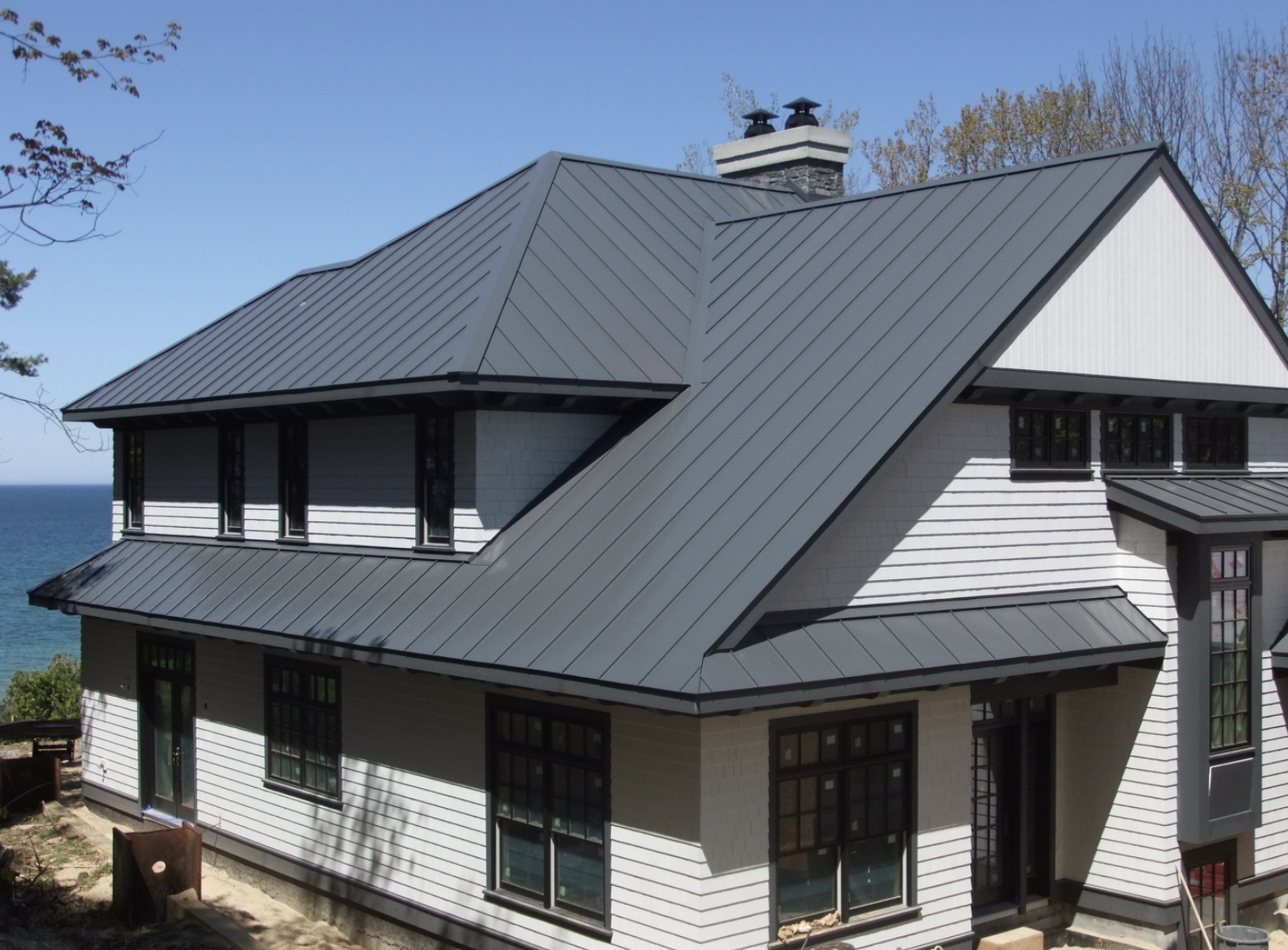
Metal Roofing
Commercial, Residential, Barn
Standing Seam, Vertical Seam, Painted, Galvanized, and More
Residential metal roofing is one of the fastest-growing segments of home improvement – more than quadrupling its market share over the past decade. The benefits offered by today’s metal roofs allow homeowners to upgrade their homes with products of lasting value. While other roofs quickly diminish in value as they age, metal roofs provide the following lasting benefits:
Proven performance expectation of 50+ years
Beautiful styles to match any home or neighborhood
Interlocking panels for maximum wind resistance
Fire resistance
Energy efficiency by keeping homes cooler
Low weight to help preserve structural integrity and life
Why Choose A Metal Roof?
This isn’t an exhaustive list of metal roofing pros, but it may contain a few surprises. There are many benefits to a Classic Metal Roofing System, and some may be more important to you, than others. We encourage you to identify what’s right for your home.
-
Control The Cost Of Maintaining Your Home
Because metal roofs do not degrade the way that most roofing materials do, a properly installed and specified quality metal roof will end your periodic “budget drains” for roof repairs or maintenance.
-
Wind Resistance
Most metal roofs feature panels that interlock or interconnect in some way. This provides superior wind resistance compared to other roofing materials that just overlap or depend upon gravity to hold things in place.
-
Low Weight
As structures age, low weight roofs help to guard against structural movement and damage, particularly in areas prone to seismic activity. Metal roofs are the lowest weight residential roofs available. This low weight also often allows a metal roof to be installed over existing shingles, eliminating landfill disposal.
-
Energy Efficiency
Through reflective coatings and integrated thermal breaks, metal roofs often reduce summer cooling costs by up to 20% or even more.
-
Fire Resistance
Metal roofs provide lasting resistance to airborne sparks and embers, protecting from exterior fires.
-
Adaptability
Metal roofs can be very adaptable to most any roof and home design. There are products for low and steep pitch roofs, products that look like wood shakes, slate, and tile, and even products well-suited for rounded or arched roofs.
-
Problem Solving
Many roofing materials rely on failure-prone sealants for difficult areas such as flashings, dead valleys, and transitions. With metal roofing, though, those areas can be flashed with matching metal – far more long-lasting and reliable than sealants and adhesives.
-
Home Additions
Traditional roofing materials tend to have frequent color and style changes, making it difficult to match older products if the home is added onto or modified in some way. Most metal roofing manufacturers are very consistent with their designs and colors, helping homeowners know that they will be able to add to their roofs at later dates.
-
Beauty
Metal roofing adds lasting distinction and beauty to a home. Other roofing materials begin a deterioration process from the first moment of installation that affects their looks over time. Metal roofing, on the other hand, can keep a very fresh “new roof” look long into the future.
-
Recycled Content
Depending on the product you choose, a quality metal roof should have recycled content from 35% – 95%. Additionally, at the end of its useful life, a metal roof should be 100% recyclable rather than require landfill disposal like other roofs
Metal Roofing Cons
There aren’t many, but each roofing application and choice of materials has its challenges. Here are the top 5 cons to choosing a Classic Metal Roof.
-
Longer Installation Time and Cost
Because metal roofs are carefully flashed to meet your roof configuration, the installation process can be longer than with standard shingles that rely heavily on sealants and mastics.
-
Increased Investment
Most metal roof customers consider themselves to be in their “forever homes,” making it easy for them to justify what is a higher cost for a higher quality product. Energy savings can also play a significant role in the eventual payback.
-
Noise
While the sound of rain on a metal roof is not what some people envision, it can be a slightly louder rumble or decibel level. It should never be “tinny” though unless perhaps you’re near an open window with very light rain. The folds and bends put into the metal break up the “soundboard” effect. If a homeowner has areas of their home with great noise sensitivity, steps can be taken when the roof is installed to keep it extra quiet. The sound of rain on a metal roof will never be nearly the level of that from rain hitting a skylight.
-
Walkability
The best thing about metal roofs regarding hail resistance and walkability is that they maintain their impact resistance as they age. Other roofing materials tend to soften or even become brittle with age, making them more prone to damage. Metal roofs can be walked, and manufacturers will provide instructions for doing so. Heavily formed metal roofs actually can be the most easily walked and can also mask any minor indentations that may occur. Some products have optional strengthening backer boards for increased rigidity.
-
Visitors
If you don’t like people asking about the curb appeal of your house, a metal roof may not be for you. Metal roofs tend to have great visibility and, on your home, a metal roof will attract interested folks who will want to talk to you about it.
